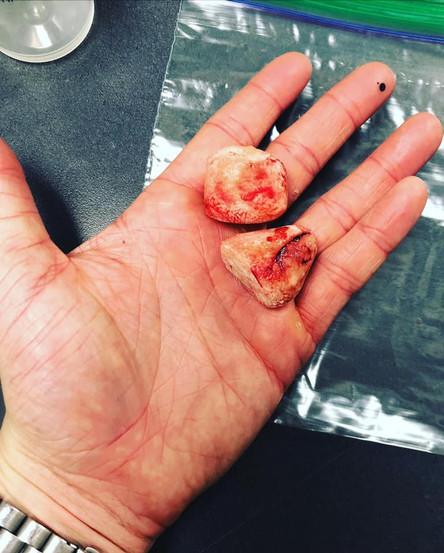URINARY STONES in dogs
- carlingmatejka

- Aug 25, 2020
- 2 min read
This adorable puppy was rescued by Saving Grace Animal Society last week because of what was found on X-rays!
Chloé had a history of peeing small amounts of blood and straining to urinate. She was quite painful in her abdomen but was otherwise normal. Her bloodwork showed that her immune system was very active! Majority of the time this means that there is either an infection or severe inflammation. Her urine had a lot of bacteria, red blood cells, and white blood cells in it. Urine should be sterile, meaning that we should not see bacteria in it. So, Chloé did have a UTI but in her case it was not that simple.
Because of the pain on abdominal palpation, X-rays were taken. As you can see on the x-ray, she has 2 VERY LARGE stones in her bladder!! Sometimes, if small enough, dogs and cats can pee out these stones or these stones can block the urethra causing an emergency situation. The only way to get rid of stones this big is by surgically removing them.
Chloé was very stable so we opted to rehydrate, give pain meds, and schedule surgery for the next day. Dr. Hook made a small abdominal incision to access her bladder. He then cut into her bladder (cystotomy) and removed the two stones. The bladder was closed and checked for urine leakage. Her abdomen was closed. These stones weighed 1% of her body weight!!
The stones have been shipped off to a laboratory in Ontario to identify the substance that they are made of so we can attempt to prevent future stones in Chloé. The most common stones (uroliths) are called Struvite and are formed from struvite crystals that form in the urine. They are usually formed because of a bacterial infection in the urine (i.e. a UTI). The bacteria changes the environment and pH of the urine allowing certain chemical reactions to take place that form struvite crystals (feel free to ask me how for all your chemistry nerds). The crystals combine together with debris in the urine to form stones!
CAUSES of struvite stones -Basic urine (acidic urine will dissolve crystals) -Urinary tract infection (UTI) -Certain drugs (long term antacids or diuretic drugs) -Certain kidney diseases
CLINICAL SIGNS -Blood in urine (hematuria) -Frequent urination (pollakiuria) -Straining to urinate (stranguria) -Inappropriate urination -Painful during abdominal palpation +/- feeling the stones
DIAGNOSIS -Clinical signs above -Bloodwork is within normal limits (majority of the time) -Urinalysis can be normal or have bacteria, blood, and/or have crystals -Xrays will show stones in bladder or/and urethra (urate and cystine stones will not show up on xray)
TREATMENT -Relive urinary tract obstruction (urethra or bladder) -Antibiotics for UTI -Diet change to veterinary diet promote acidic urine and struvite crystal dissolution -Promote water consumption in pet -Recheck urinalysis/ radiographs **if stones are small enough, diet change alone may be successful to dissolve stones**
PROGNOSIS
-Good!









Comments